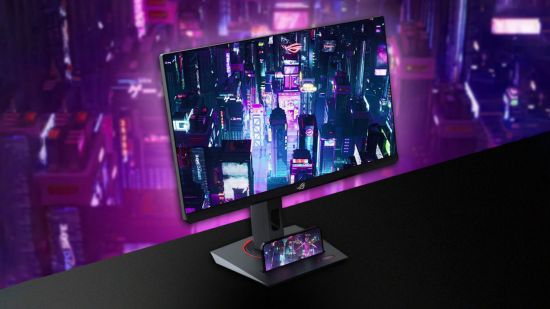Asus has just announced its new Asus ROG Strix XG27UCS gaming monitor, which is a 27-inch, 160Hz, 4K screen with some genuinely useful features and compelling specs. The headline feature is a rather cheesy-sounding mobile device stand, but there’s a lot more going on here.
With Asus having long been a maker of some of the best gaming monitors around, it has plenty of pedigree when it comes to the basics, but this new screen offers something a little different.
So this mobile phone stand, then. It’s a slot in the front of the monitor’s stand/base. Yup, that’s it. Before you dismiss it as a silly idea, though, there are a couple of factors to highlight.
First, it’s just quite a useful feature. The space underneath your monitor is so often wasted, and we welcome any way in which it can be made more useful, whether that’s by making the base completely flat as on the Samsung G95SC, or adding a feature like this mobile phone stand.

Moreover, Asus’ top-tier ROG Swift gaming monitors, such as the PG27AQN, have tended to have stand designs that look quite smart but are impractical with their long V-shaped feet getting in the way of stuff on your desk. Here, though, you get a simple rectangular foot that makes for a useful place to stow and see your phone or tablet, although a large tablet would block the bottom of your screen.
What’s more, the screen includes USB-C input so you can in theory hook up your phone (or tablet or laptop) to the screen. The monitor doesn’t quite go as far as offering a KVM feature for this input but it’s still a neat way to make the stand even more useful.
As for the rest of the screen, a 160Hz refresh rate is nothing too spectacular, even with a 4K resolution (there are several 240Hz 4K displays these days), but it’s still a great combination for providing ultra-sharp-looking, smooth gameplay. There are some other subtle welcome extras too.
Along with G-Sync (and FreeSync / adaptive sync) compatibility, the screen also has Asus’ ELMB-Sync technology. This allows the screen to offer backlight-strobing motion blur reduction at the same time as the variable refresh rate tech of G-Sync/FreeSync. Most screens still can only offer backlight strobing when adaptive sync is turned off.
What’s more, the panel supports variable overdrive too. This allows the screen to adjust its overdrive setting in accordance with the variable refresh rate, ensuring the best setting is used no matter how much your frame rate fluctuates. This reduces the appearance of ghosting and inverse ghosting when compared to fixed overdrive displays using adaptive sync.
Without a zoned backlight, the screen doesn’t offer dazzling high-contrast HDR reproduction, but it does support 95% of the extended DCI-P3 color range required for HDR, meaning you’ll get highly saturated colors.
There are just three causes of concern with this display. The first is that its display inputs use older standards, so in theory they don’t support 4K at 160Hz without some compression. Secondly, the price isn’t exactly cheap at €669.90, which works out at roughly $700 US. Thirdly, and most importantly, this display is for now only launching in Austria, Germany, and Switzerland.
As such, buyers elsewhere will just have to make do with the likes of the Asus PG32UCDM or Gigabyte FO32U2P if you want some 240Hz, 4K gaming fun.
